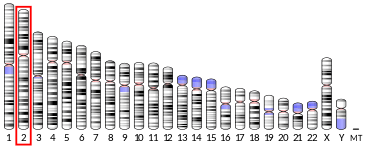LRRTM1
LRRTM1 is a brain-expressed imprinted gene that encodes a leucine-rich repeat transmembrane protein that interacts with neurexins and neuroligins to modulate synaptic cell adhesion in neurons.[5][6] As the name implies, its protein product is a transmembrane protein that contains many leucine rich repeats. It is expressed during the development of specific forebrain structures and shows a variable pattern of maternal downregulation (genomic imprinting).[7][8]
Clinical significance
LRRTM1 is the first gene linked to increased odds of being left-handed, when inherited from the father's side.[9] Possessing one particular variant of the LRRTM1 gene slightly raises the risk of psychotic mental illnesses such as schizophrenia, again only if inherited from the father's side.[9] As well, LRRTM1 has been associated with measures of schizotypy in non-clinical populations,[10] indicating that the gene may have shared effects on neurodevelopment in both healthy and unhealthy individuals and individuals with schizophrenia.
LRRTM1 is also critically involved in synapse formation within the dorsal Lateral geniculate nucleus (dLGN) of mice. LRRTM1 aids in the assembly of complex retinogenciulate synapses in mice, which are believed to help process complex visual signals. Lack of this gene shows decreased performance in complex visual tasks.[11]
See also
References
- GRCh38: Ensembl release 89: ENSG00000162951 - Ensembl, May 2017
- GRCm38: Ensembl release 89: ENSMUSG00000060780 - Ensembl, May 2017
- "Human PubMed Reference:". National Center for Biotechnology Information, U.S. National Library of Medicine.
- "Mouse PubMed Reference:". National Center for Biotechnology Information, U.S. National Library of Medicine.
- Siddiqui TJ, Pancaroglu R, Kang Y, Rooyakkers A, Craig AM (June 2010). "LRRTMs and neuroligins bind neurexins with a differential code to cooperate in glutamate synapse development". The Journal of Neuroscience. 30 (22): 7495–506. doi:10.1523/JNEUROSCI.0470-10.2010. PMC 2896269. PMID 20519524.
- Soler-Llavina GJ, Fuccillo MV, Ko J, Südhof TC, Malenka RC (October 2011). "The neurexin ligands, neuroligins and leucine-rich repeat transmembrane proteins, perform convergent and divergent synaptic functions in vivo". Proceedings of the National Academy of Sciences of the United States of America. 108 (40): 16502–9. doi:10.1073/pnas.1114028108. PMC 3189075. PMID 21953696.
- "Entrez Gene: leucine rich repeat transmembrane neuronal 1".
- Laurén J, Airaksinen MS, Saarma M, Timmusk T (April 2003). "A novel gene family encoding leucine-rich repeat transmembrane proteins differentially expressed in the nervous system". Genomics. 81 (4): 411–21. doi:10.1016/S0888-7543(03)00030-2. PMID 12676565.
- Francks C, Maegawa S, Laurén J, Abrahams BS, Velayos-Baeza A, Medland SE, et al. (December 2007). "LRRTM1 on chromosome 2p12 is a maternally suppressed gene that is associated paternally with handedness and schizophrenia". Molecular Psychiatry. 12 (12): 1129–39, 1057. doi:10.1038/sj.mp.4002053. PMC 2990633. PMID 17667961. Lay summary – BBC News.
- Leach EL, Prefontaine G, Hurd PL, Crespi BJ (June 2014). "The imprinted gene LRRTM1 mediates schizotypy and handedness in a nonclinical population". Journal of Human Genetics. 59 (6): 332–6. doi:10.1038/jhg.2014.30. PMID 24785688.
- Van Name, Jonathan; Monavarfeshani, Aboozar; Fox, Michael (July 2017). "The role of complex retinogeniculate synapses in mouse visual behavior". Cite journal requires
|journal=(help)
Further reading
- Leach EL, Prefontaine G, Hurd PL, Crespi BJ (June 2014). "The imprinted gene LRRTM1 mediates schizotypy and handedness in a nonclinical population". Journal of Human Genetics. 59 (6): 332–6. doi:10.1038/jhg.2014.30. PMID 24785688.
- Sousa I, Clark TG, Holt R, Pagnamenta AT, Mulder EJ, Minderaa RB, et al. (March 2010). "Polymorphisms in leucine-rich repeat genes are associated with autism spectrum disorder susceptibility in populations of European ancestry". Molecular Autism. 1 (1): 7. doi:10.1186/2040-2392-1-7. PMC 2913944. PMID 20678249.
- Crow TJ, Close JP, Dagnall AM, Priddle TH (January 2009). "Where and what is the right shift factor or cerebral dominance gene? A critique of Francks et al. (2007)". Laterality. 14 (1): 3–10. doi:10.1080/13576500802574984. PMID 19125366.
- Maruyama K, Sugano S (January 1994). "Oligo-capping: a simple method to replace the cap structure of eukaryotic mRNAs with oligoribonucleotides". Gene. 138 (1–2): 171–4. doi:10.1016/0378-1119(94)90802-8. PMID 8125298.
- Clark HF, Gurney AL, Abaya E, Baker K, Baldwin D, Brush J, et al. (October 2003). "The secreted protein discovery initiative (SPDI), a large-scale effort to identify novel human secreted and transmembrane proteins: a bioinformatics assessment". Genome Research. 13 (10): 2265–70. doi:10.1101/gr.1293003. PMC 403697. PMID 12975309.
- Ludwig KU, Mattheisen M, Mühleisen TW, Roeske D, Schmäl C, Breuer R, et al. (August 2009). "Supporting evidence for LRRTM1 imprinting effects in schizophrenia". Molecular Psychiatry. 14 (8): 743–5. doi:10.1038/mp.2009.28. PMID 19626025.
- McManus C, Nicholls M, Vallortigara G (January 2009). "Editorial commentary: is LRRTM1 the gene for handedness?". Laterality. 14 (1): 1–2. doi:10.1080/13576500802542577. PMID 19125365.
- Suzuki Y, Yoshitomo-Nakagawa K, Maruyama K, Suyama A, Sugano S (October 1997). "Construction and characterization of a full length-enriched and a 5'-end-enriched cDNA library". Gene. 200 (1–2): 149–56. doi:10.1016/S0378-1119(97)00411-3. PMID 9373149.
- Francks C (January 2009). "Understanding the genetics of behavioural and psychiatric traits will only be achieved through a realistic assessment of their complexity". Laterality. 14 (1): 11–6. doi:10.1080/13576500802536439. hdl:11858/00-001M-0000-0012-C72F-9. PMID 19125367.



